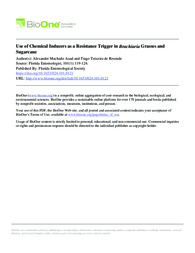Use of chemical inducers as a resistance trigger in Brachiaria grasses and sugarcane.
Use of chemical inducers as a resistance trigger in Brachiaria grasses and sugarcane.
Author(s): AUAD, A. M.; RESENDE, T. T. de
Summary: Abstract Chemical inducers have relevant roles in activating the defense responses of plants to insects. The present research examines the defense mechanisms of Brachiaria (Poaceae) grasses and sugarcane cultivars exposed to exogenous of chemical inducers with and without injury due to Mahanarva spectabilis (Distant) (Hemiptera: Cercopidae). Plants were subjected to herbivory by spittlebug nymphs and to 3 chemical inducers: salicylic acid, silicic acid, and nitric oxide. Dry matter was calculated at 15 d after induction, and extraction and quantification of phenolic compounds were performed. The phenolic content and percentage of dry matter of the plants was evaluated by analysis of variance, and means were compared by the Scott-Knott test (P < 0.005). Changes in dry matter were assessed with regard to interactions between inducers and Brachiaria roots and sugarcane shoots. Salicylic acid, silicic acid, and nitric oxide, as well as attack by M. spectabilis, triggered alterations in phenolic contents. The highest and lowest concentrations of phenolic compounds were found in the standard cultivar susceptible (cv. Basilik) and resistant to the insect pest (cv. Marandu), respectively. However, the results showed that inducers failed to impact the defense mechanism of Brachiaria cultivars and that assessment of total phenolic compounds is not the most adequate approach for measuring resistance in these cultivars. In sugarcane, inducers did not appear to act on defense mechanisms, though the resistant cultivar did exhibit a greater phenolic content. Hence, the use of the above chemical inducers is not useful for triggering resistance in Bracharia and sugarcane.
Publication year: 2018
Types of publication: Journal article
Unit: Embrapa Dairy Cattle
Keywords: Forage, Herbivory, Induced resistance, Phenolic compounds
Observation
Some of Embrapa's publications are published as ePub files. To read them, use or download one of the following free software options to your computer or mobile device. Android: Google Play Books; IOS: iBooks; Windows and Linux: Calibre.
Access other publications
Access the Agricultural Research Database (BDPA) to consult Embrapa's full library collection and records.
Visit Embrapa Bookstore to purchase books and other publications sold by Embrapa.

